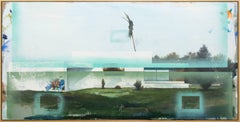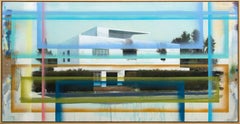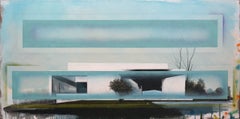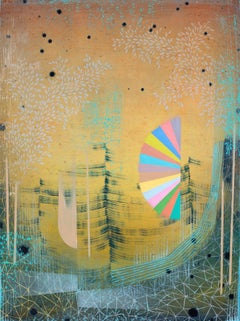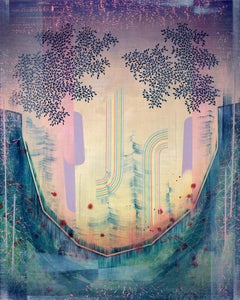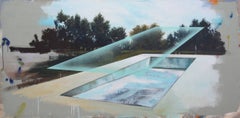Ceramic Landscape Paintings
to
3
Overall Width
to
Overall Height
to
3
3
3
96,170
48
48
48
38
60
3
2
2
1
1
Medium: Ceramic
Artist: Peter Hoffer
Illuminati - large, blue, architecture, abstract landscape mixed media on linen
By Peter Hoffer
Located in Bloomfield, ON
Peter Hoffer’s landscapes have one foot in classic realism and the other in deconstruction. This work, created with clay silicate and pigment on linen, juxtapose the Bauhaus architec...
Category
2010s Contemporary Ceramic Landscape Paintings
Materials
Clay, Linen, Pigment
Bauhaus No 02 - large, blue, green, architecture, deconstruction, mixed media
By Peter Hoffer
Located in Bloomfield, ON
Peter Hoffer’s landscapes have one foot in classic realism and the other in deconstruction. This work, created with clay silicate and pigment on linen, juxtapose the Bauhaus architec...
Category
2010s Contemporary Ceramic Landscape Paintings
Materials
Clay, Linen, Pigment
Bauhaus No 01 - large, blue, green, architecture, deconstruction, mixed media
By Peter Hoffer
Located in Bloomfield, ON
Peter Hoffer’s landscapes have one foot in classic realism and the other in deconstruction. This work, created with clay silicate and pigment on linen, juxtapose the Bauhaus architec...
Category
2010s Contemporary Ceramic Landscape Paintings
Materials
Clay, Linen, Pigment
Related Items
Hello Sunshine, Yellow, Indigo Blue, Pink, Aqua Abstract Patterns
By Gabe Brown
Located in Kent, CT
Carefully ordered patterns, geometric shapes and delicate lines in light blue, lime green, indigo, pink and aqua on a luminous golden yellow background. Signed, dated and titled on v...
Category
2010s Contemporary Ceramic Landscape Paintings
Materials
Linen, Oil, Panel
$1,800
H 16 in W 12 in D 1 in
Sightseer - Contemporary Abstract Landscape Pattern Stripes Leaves Lilac, 2023
By Gabe Brown
Located in Kent, CT
Contemporary abstract landscape painting in oil on linen mounted on panel with carefully ordered patterns, geometric shapes and delicate lines in prismatic colors against a light pin...
Category
2010s Contemporary Ceramic Landscape Paintings
Materials
Linen, Oil, Panel
$3,400
H 30 in W 24 in D 1 in
Red Earth - Contemporary Abstract Landscape Pattern Stripes Leaves Peach, 2023
By Gabe Brown
Located in Kent, CT
Contemporary abstract landscape painting in oil on linen mounted on panel with carefully ordered patterns, geometric shapes and delicate lines in bright prismatic colors against a li...
Category
2010s Contemporary Ceramic Landscape Paintings
Materials
Linen, Oil, Panel
$2,400
H 20 in W 16 in D 1 in
Seascape – Contemporary Abstract Painting, Pigment & Acrylic on Canvas large art
Located in Agrigento, AG
Details:
Artist: Marilina Marchica (1984, Italy)
Title: Seascape
Year: 2025
Medium: Pure pigment and acrylic on canvas
Dimensions: 70 × 100 × 1.7 cm (27.6 × 39.4 × 0.7 in)
Support: S...
Category
2010s Contemporary Ceramic Landscape Paintings
Materials
Canvas, Acrylic, Pigment
$2,382
H 39.38 in W 27.56 in D 0.67 in
Subdue, 10x10" oil on linen
Located in Loveland, CO
"Subdue" by Alyson Kinkade
Abstract Landscape
Oil on Linen 10x10" image
12x12" framed in black wood as pictured
*Shipping price includes the custom packing necessary for safe transp...
Category
2010s Contemporary Ceramic Landscape Paintings
Materials
Linen, Oil
Senses - Abstract Landscape, Contemporary Woven and Painted Artwork
Located in Salzburg, AT
Senses, 2021, Horizons Series
Handwoven painting, linen, cotton yarn, acrylic textile paint, 65 x 50 cm
‘Horizons’ are a symbiosis of two disciplines of art, Painting and Weaving. ...
Category
2010s Contemporary Ceramic Landscape Paintings
Materials
Textile, Linen, Yarn, Acrylic
$1,915
H 25.6 in W 19.69 in D 0.79 in
Limitless Triptych
Located in Loveland, CO
Limitless Triptych by Alyson Kinkade
Each canvas is 20x15", oil on linen on thick stretcher bars.
22x51x1.5" overall dimensions. Framed in black wood - floater frames as pictured
"W...
Category
2010s Contemporary Ceramic Landscape Paintings
Materials
Canvas, Oil, Stretcher Bars, Linen
"White Landscape" Abstract landscape Painting , Original art Made in Italy
Located in Agrigento, AG
White Landscape
oil on canvas 60x81cm
2025
original art
Ready to hang
certificate of authenticity included
Marilina Marchica was born in Agrigento, where she works and lives,
Afte...
Category
2010s Contemporary Ceramic Landscape Paintings
Materials
Canvas, Oil, Pigment
$1,628 Sale Price
20% Off
H 31.89 in W 23.63 in D 0.79 in
Flowering - Handwoven Abstract Landscape, Contemporary Woven and Painted Artwork
Located in Salzburg, AT
From the series Horizons – Sunset 2023
Handwoven painting, linen, cotton yarn, acrylic textile paint, 65 x 50 cm.
‘Horizons’ are a symbiosis of two disciplines of art, Painting and...
Category
2010s Contemporary Ceramic Landscape Paintings
Materials
Textile, Cotton, Linen, Yarn, Acrylic
$1,616
H 15.75 in W 19.69 in D 0.79 in
Landscape Bw Original Art on Canvas Made in Italy on of a Kind
Located in Agrigento, AG
Landscape BW is a unique and original artwork created with mineral oxide on round canvas (40 cm diameter).
Part of Marilina Marchica’s ongoing research on landscape and sign, the pie...
Category
2010s Contemporary Ceramic Landscape Paintings
Materials
Pigment, Canvas
$1,795
H 15.75 in Dm 15.75 in
Timeless - Handwoven Landscape Painting, Modern Painted and Woven Artwork
Located in Salzburg, AT
"Timeless", from the series Horizons, handwoven painting, linen yarn, acrylic textile paint, 60 x 80 cm, 2022.
Canvas is entirely constructed on a weaving loom...
Category
2010s Contemporary Ceramic Landscape Paintings
Materials
Textile, Linen, Yarn, Acrylic
$1,975
H 23.63 in W 31.5 in D 0.79 in
Horizon, Cabo Sardão - Abstract Landscape, Contemporary Painted + Woven Artwork
Located in Salzburg, AT
‘Horizon. Cabo Sardão’ 2020
Handwoven painting, linen, woollen, silk, cotton yarn, acrylic textile paint, 130 x 65 cm
Handwoven painting from the series ‘Horizons’, based on a portuguese landscape...
Category
2010s Contemporary Ceramic Landscape Paintings
Materials
Textile, Linen, Yarn, Acrylic
$2,334
H 53.15 in W 25.6 in D 0.79 in
Previously Available Items
Swimming Pool - large, blue, green, architecture, deconstruction, mixed media
By Peter Hoffer
Located in Bloomfield, ON
Peter Hoffer’s landscapes have one foot in classic realism and the other in deconstruction. Often Hoffer uses mixed media on wood with high gloss resin, but this particular work is p...
Category
2010s Contemporary Ceramic Landscape Paintings
Materials
Clay, Linen, Pigment
Plein
By Peter Hoffer
Located in Bloomfield, ON
Peter Hoffer’s landscapes have one foot in classic realism and the other in deconstruction. Often Hoffer uses mixed media on wood with high gloss resin, but this particular work is p...
Category
2010s Contemporary Ceramic Landscape Paintings
Materials
Clay, Raw Linen, Pigment
Portrait No. 1
By Peter Hoffer
Located in Bloomfield, ON
Peter Hoffer’s landscapes have one foot in classic realism and the other in deconstruction. Often Hoffer uses mixed media on wood with high gloss resin, but this particular work is p...
Category
21st Century and Contemporary Modern Ceramic Landscape Paintings
Materials
Pigment, Raw Linen, Clay
Portrait (2)
By Peter Hoffer
Located in Bloomfield, ON
Peter Hoffer was born in Brantford On. 1965. He has a M.F.A. from Concordia University in Montréal, degrees from the University of Guelph, Ontario, and the Ontario College of Art in ...
Category
21st Century and Contemporary Ceramic Landscape Paintings
Materials
Pigment, Raw Linen, Clay
Ceramic landscape paintings for sale on 1stDibs.
Find a wide variety of authentic Ceramic landscape paintings available on 1stDibs. While artists have worked in this medium across a range of time periods, art made with this material during the 21st Century is especially popular. If you’re looking to add landscape paintings created with this material to introduce a provocative pop of color and texture to an otherwise neutral space in your home, the works available on 1stDibs include elements of blue, green, purple and other colors. There are many well-known artists whose body of work includes ceramic sculptures. Popular artists on 1stDibs associated with pieces like this include Roger König, Jared Fitzgerald, Peter Hoffer, and Königliche Porzellan-Manufaktur (KPM). Frequently made by artists working in the Abstract, Contemporary, all of these pieces for sale are unique and many will draw the attention of guests in your home. Not every interior allows for large Ceramic landscape paintings, so small editions measuring 0.1 inches across are also available
Recently Viewed
View AllMore Ways To Browse
Western Cloud Landscape
A T Hibbard
Alfred Bachmann
Alfred Emile Leopold Stevens
Amsterdam Cityscape Paintings
Andre Beauce
Auseklis Ozols
Bardone Oil Paintings
Barge Board
Besse Raymond
Birch Trees Forest Painting
Bolton Abbey
Boothbay Harbor Paintings
Borlase Smart
British Naive Paintings
Bruno Cote
Calderon Landscape
California Beach Scene Art
